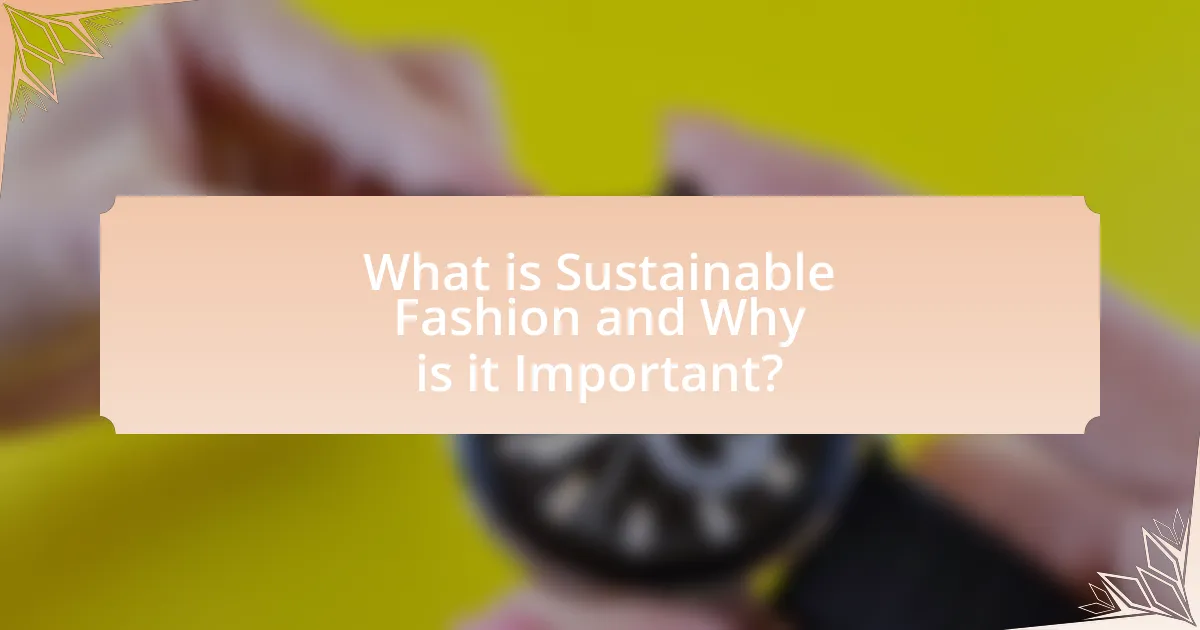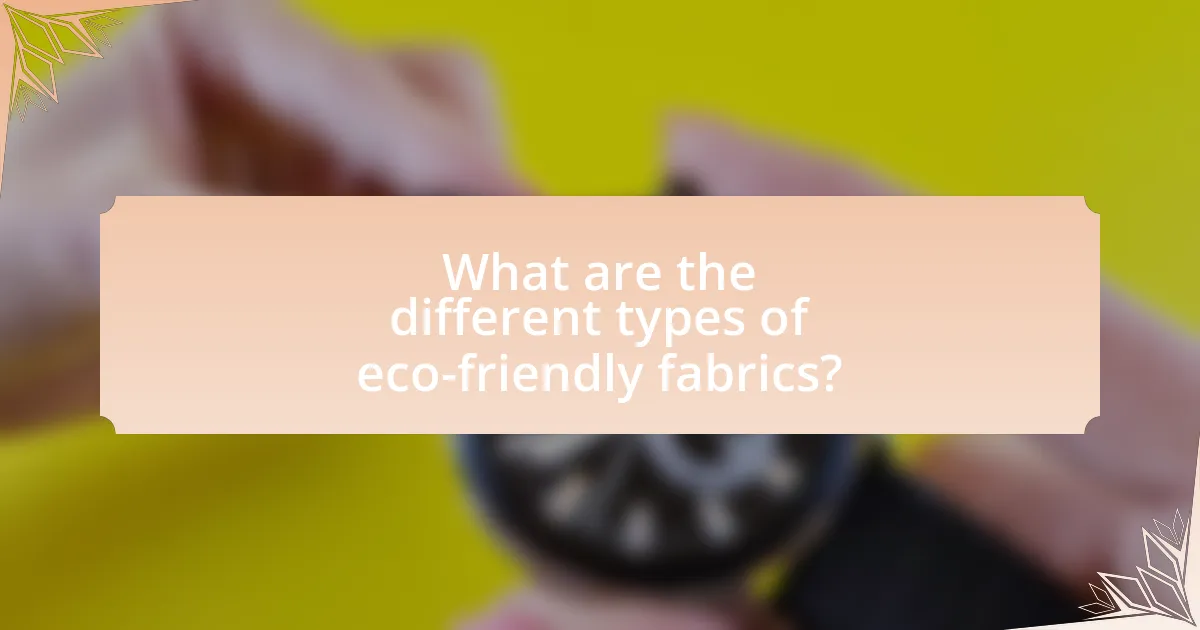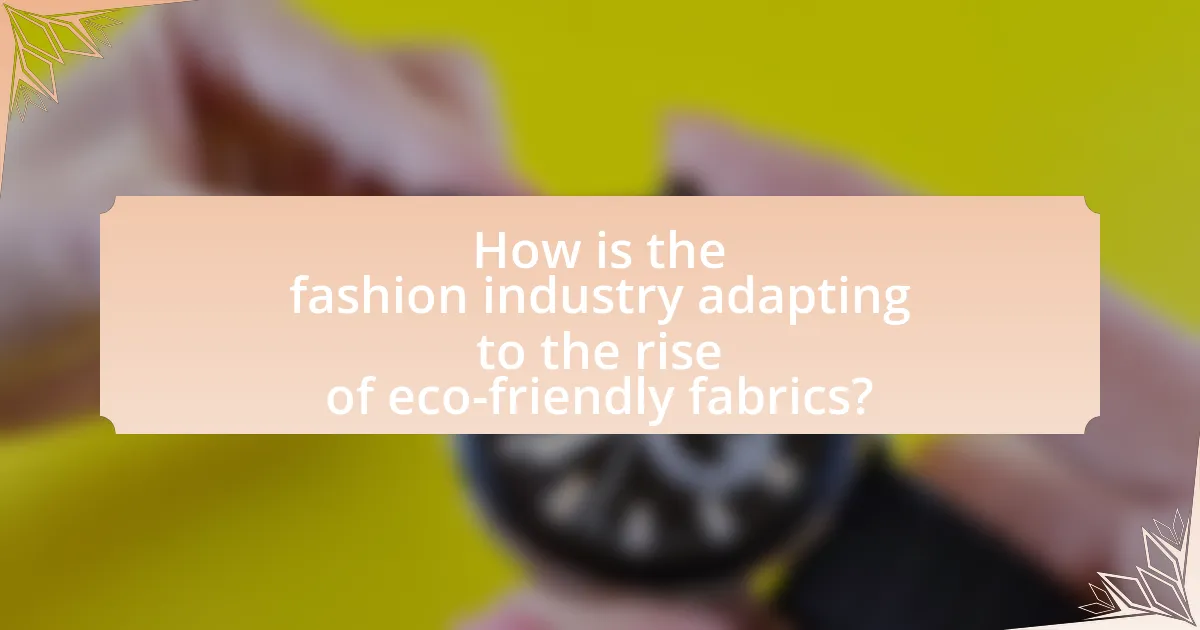Sustainable fashion is defined as clothing and accessories produced, consumed, and disposed of in environmentally friendly and socially responsible ways. This article explores the importance of sustainable fashion in mitigating the fashion industry’s significant environmental impact, which accounts for about 10% of global carbon emissions. Key principles such as ethical production, resource efficiency, and circularity are discussed, alongside the role of eco-friendly fabrics like organic cotton, hemp, and recycled materials. The article also highlights the challenges brands face in adopting sustainable practices, the influence of consumer demand, and various initiatives promoting eco-friendly fabrics, ultimately emphasizing the need for increased consumer awareness and responsible purchasing choices.

What is Sustainable Fashion and Why is it Important?
Sustainable fashion refers to clothing and accessories that are produced, consumed, and disposed of in ways that are environmentally friendly and socially responsible. This approach is important because it addresses the significant environmental impact of the fashion industry, which is responsible for approximately 10% of global carbon emissions and substantial water pollution. By prioritizing sustainable practices, such as using eco-friendly materials and ethical labor practices, sustainable fashion aims to reduce waste, lower carbon footprints, and promote fair treatment of workers, ultimately contributing to a healthier planet and society.
How does Sustainable Fashion differ from traditional fashion?
Sustainable fashion prioritizes environmental and social responsibility, while traditional fashion often emphasizes rapid production and consumption. Sustainable fashion utilizes eco-friendly materials, such as organic cotton and recycled fabrics, reducing environmental impact, whereas traditional fashion frequently relies on synthetic materials that contribute to pollution. According to the Ellen MacArthur Foundation, the fashion industry is responsible for 10% of global carbon emissions, highlighting the need for sustainable practices to mitigate climate change.
What are the key principles of Sustainable Fashion?
The key principles of Sustainable Fashion include ethical production, resource efficiency, and circularity. Ethical production emphasizes fair labor practices and transparency in the supply chain, ensuring that workers are treated fairly and compensated adequately. Resource efficiency focuses on minimizing waste and reducing the environmental impact of materials used in fashion, such as opting for organic or recycled fabrics. Circularity promotes the idea of designing products for longevity and recyclability, encouraging consumers to recycle or upcycle garments rather than discarding them. These principles collectively aim to create a more sustainable and responsible fashion industry, addressing both environmental and social issues.
Why is consumer awareness crucial for Sustainable Fashion?
Consumer awareness is crucial for sustainable fashion because it drives demand for eco-friendly products and practices. When consumers are informed about the environmental and social impacts of their clothing choices, they are more likely to support brands that prioritize sustainability. Research indicates that 66% of global consumers are willing to pay more for sustainable brands, highlighting the economic influence of consumer awareness. This awareness encourages companies to adopt sustainable practices, such as using organic materials and ethical labor, ultimately leading to a reduction in the fashion industry’s carbon footprint and waste.
What role do eco-friendly fabrics play in Sustainable Fashion?
Eco-friendly fabrics are essential in sustainable fashion as they significantly reduce environmental impact. These materials, such as organic cotton, hemp, and recycled polyester, are produced with minimal use of harmful chemicals and resources, promoting a healthier ecosystem. For instance, organic cotton uses 91% less water than conventional cotton, highlighting its efficiency in resource conservation. Additionally, eco-friendly fabrics often utilize renewable resources and biodegradable materials, which help decrease waste in landfills. By integrating these fabrics, the fashion industry can transition towards more sustainable practices, aligning with consumer demand for environmentally responsible products.
How are eco-friendly fabrics defined?
Eco-friendly fabrics are defined as textiles made from sustainable materials that minimize environmental impact throughout their lifecycle. These fabrics often originate from organic fibers, recycled materials, or renewable resources, and are produced using processes that reduce water consumption, chemical usage, and carbon emissions. For instance, organic cotton is grown without synthetic pesticides, while recycled polyester is made from post-consumer plastic bottles, significantly lowering waste and resource depletion.
What are the environmental impacts of conventional fabrics?
Conventional fabrics have significant environmental impacts, primarily due to their production processes, which often involve high water consumption, pesticide use, and carbon emissions. For instance, cotton farming requires approximately 7,000 liters of water to produce just one kilogram of cotton, leading to water scarcity in many regions. Additionally, synthetic fabrics like polyester are derived from petroleum, contributing to fossil fuel depletion and greenhouse gas emissions during their production. The dyeing and finishing processes of these fabrics also release toxic chemicals into waterways, harming aquatic ecosystems. According to the Ellen MacArthur Foundation, the fashion industry is responsible for 10% of global carbon emissions, highlighting the urgent need for sustainable alternatives.

What are the different types of eco-friendly fabrics?
Eco-friendly fabrics include organic cotton, hemp, linen, Tencel, and recycled polyester. Organic cotton is grown without synthetic pesticides or fertilizers, reducing environmental impact. Hemp requires minimal water and no pesticides, making it a sustainable choice. Linen, derived from flax plants, is biodegradable and uses fewer resources. Tencel, made from sustainably sourced wood pulp, is produced in a closed-loop process that recycles water and solvents. Recycled polyester is created from post-consumer plastic bottles, diverting waste from landfills and reducing reliance on virgin materials. These fabrics contribute to sustainable fashion by minimizing ecological footprints and promoting responsible production practices.
What natural fibers are considered eco-friendly?
Natural fibers considered eco-friendly include organic cotton, linen, hemp, and bamboo. Organic cotton is grown without synthetic pesticides or fertilizers, reducing environmental impact. Linen, made from flax plants, requires less water and chemicals compared to conventional cotton. Hemp is a fast-growing plant that enriches the soil and needs minimal resources. Bamboo grows rapidly and can be harvested sustainably, making it a renewable resource. These fibers contribute to sustainable fashion by minimizing ecological footprints and promoting environmentally responsible practices.
How is organic cotton produced sustainably?
Organic cotton is produced sustainably through methods that prioritize environmental health and social responsibility. This production process avoids synthetic pesticides and fertilizers, relying instead on natural alternatives and crop rotation to maintain soil fertility and reduce pest populations. Additionally, organic cotton farming uses non-GMO seeds and promotes biodiversity, which helps to protect ecosystems. According to the Global Organic Textile Standard (GOTS), organic cotton must be grown in accordance with strict environmental and social criteria, ensuring fair labor practices and minimal environmental impact. This approach not only conserves water and reduces pollution but also supports the livelihoods of farmers by promoting sustainable agricultural practices.
What are the benefits of using hemp in fashion?
Hemp offers numerous benefits in fashion, primarily due to its sustainability and versatility. The plant requires minimal water, no pesticides, and grows rapidly, making it an eco-friendly alternative to conventional fabrics like cotton. Additionally, hemp fibers are strong, durable, and biodegradable, contributing to a reduced environmental impact at the end of the product’s life cycle. Studies indicate that hemp cultivation can improve soil health and sequester carbon, further enhancing its appeal in sustainable fashion initiatives.
What synthetic fabrics can be classified as eco-friendly?
Eco-friendly synthetic fabrics include recycled polyester, Tencel (lyocell), and Econyl. Recycled polyester is made from post-consumer plastic bottles, reducing waste and energy consumption compared to virgin polyester production. Tencel, derived from sustainably sourced wood pulp, uses a closed-loop process that recycles water and solvents, minimizing environmental impact. Econyl is produced from recycled nylon waste, such as fishing nets, and can be regenerated infinitely without losing quality. These fabrics demonstrate a commitment to sustainability by utilizing recycled materials and eco-conscious manufacturing processes.
How is recycled polyester made and what are its advantages?
Recycled polyester is made by processing plastic waste, primarily PET (polyethylene terephthalate) bottles and containers, through a series of steps that include collection, cleaning, shredding, and melting to create new fibers. This process diverts plastic from landfills and reduces the need for virgin polyester production, which is energy-intensive and contributes to environmental pollution.
The advantages of recycled polyester include a significant reduction in carbon emissions, as producing recycled polyester can use up to 59% less energy compared to virgin polyester production. Additionally, it helps conserve natural resources by reducing the demand for petroleum, the primary raw material for virgin polyester. Furthermore, using recycled materials promotes a circular economy, encouraging sustainable practices in the fashion industry.
What innovations exist in the production of biodegradable fabrics?
Innovations in the production of biodegradable fabrics include the development of materials such as Tencel, made from sustainably sourced wood pulp, and biodegradable polyester derived from renewable resources. Tencel, produced by Lenzing AG, utilizes a closed-loop process that recycles water and solvents, minimizing environmental impact. Biodegradable polyester, often created from plant-based sources like corn starch, can decompose in industrial composting facilities within a few months, unlike traditional polyester which can take hundreds of years to break down. Additionally, advancements in microbial fermentation processes are enabling the creation of bio-based fibers, such as those produced by companies like Spiber, which uses engineered microorganisms to synthesize proteins into fabric. These innovations collectively contribute to reducing waste and promoting sustainability in the fashion industry.

How is the fashion industry adapting to the rise of eco-friendly fabrics?
The fashion industry is adapting to the rise of eco-friendly fabrics by integrating sustainable materials into their production processes and redesigning supply chains to prioritize environmental impact. Major brands are increasingly using organic cotton, recycled polyester, and innovative materials like Tencel and hemp, which have lower environmental footprints compared to traditional fabrics. For instance, a report by McKinsey & Company indicates that the global market for sustainable fashion is projected to grow significantly, reflecting consumer demand for eco-conscious products. Additionally, initiatives such as the Fashion Pact, which includes over 60 companies, aim to set standards for sustainability in the industry, further demonstrating the commitment to eco-friendly practices.
What are the challenges faced by brands in adopting eco-friendly fabrics?
Brands face several challenges in adopting eco-friendly fabrics, primarily including higher costs, limited availability, and consumer awareness. The production of eco-friendly fabrics often incurs greater expenses due to sustainable sourcing and manufacturing processes, which can lead to increased retail prices. Additionally, the supply chain for these materials is not as developed as conventional fabrics, resulting in limited options for brands. Furthermore, many consumers lack awareness or understanding of the benefits of eco-friendly fabrics, making it difficult for brands to justify the transition and educate their target market effectively. These challenges hinder the widespread adoption of sustainable materials in the fashion industry.
How can brands overcome the cost barriers associated with sustainable materials?
Brands can overcome the cost barriers associated with sustainable materials by investing in innovative production technologies and forming strategic partnerships with suppliers. By adopting advanced manufacturing processes, such as 3D printing and automation, brands can reduce waste and lower production costs. Additionally, collaborating with suppliers who specialize in sustainable materials can lead to bulk purchasing discounts and shared research and development costs, making eco-friendly options more financially viable. For instance, a study by McKinsey & Company highlights that companies that invest in sustainable supply chains can achieve cost savings of up to 20% over time due to increased efficiency and reduced resource consumption.
What role does consumer demand play in this transition?
Consumer demand is a critical driver in the transition to sustainable fashion and the adoption of eco-friendly fabrics. As consumers increasingly prioritize environmental sustainability, their purchasing choices influence brands to adopt greener practices and materials. For instance, a 2021 survey by McKinsey & Company found that 67% of consumers consider sustainability when making fashion purchases, prompting brands to innovate and offer sustainable options. This shift in consumer behavior not only encourages the fashion industry to reduce its environmental impact but also fosters a competitive market for eco-friendly products, ultimately accelerating the transition towards sustainable fashion.
What initiatives are being taken to promote eco-friendly fabrics?
Various initiatives are being implemented to promote eco-friendly fabrics, including government regulations, industry collaborations, and consumer awareness campaigns. Governments are enacting policies that incentivize sustainable practices, such as tax breaks for companies using organic materials or funding for research in sustainable textile technologies. Industry collaborations, like the Sustainable Apparel Coalition, are working to create standards for eco-friendly materials and practices, encouraging brands to adopt more sustainable sourcing methods. Additionally, consumer awareness campaigns are educating the public about the environmental impact of fabric choices, leading to increased demand for eco-friendly options. These initiatives collectively aim to reduce the environmental footprint of the fashion industry and promote the use of sustainable materials.
How do certifications and labels influence consumer choices?
Certifications and labels significantly influence consumer choices by providing assurance of product quality and sustainability. Research indicates that consumers are more likely to purchase products with recognized certifications, such as organic or fair trade labels, as these indicators signal ethical practices and environmental responsibility. For instance, a study published in the Journal of Consumer Research found that 66% of consumers are willing to pay more for products with eco-labels, demonstrating a clear preference for certified goods. This trend is particularly evident in the sustainable fashion sector, where labels like GOTS (Global Organic Textile Standard) and OEKO-TEX assure consumers of eco-friendly practices, thereby enhancing their purchasing decisions.
What are some successful case studies of brands using eco-friendly fabrics?
Patagonia is a leading example of a brand successfully using eco-friendly fabrics, specifically through its use of recycled polyester made from plastic bottles. This initiative has allowed Patagonia to recycle over 86 million plastic bottles into fabric since 1993, significantly reducing waste and promoting sustainability in the fashion industry. Another notable case is Stella McCartney, which has integrated organic cotton and recycled materials into her collections, emphasizing animal welfare and environmental responsibility. McCartney’s commitment to sustainability has garnered recognition, including the 2021 Green Carpet Fashion Award for Best Sustainable Brand. Additionally, Eileen Fisher has implemented a program called “Renew,” which encourages customers to return used garments for recycling, thus promoting circular fashion. This initiative has diverted over 1.5 million garments from landfills since its inception. These case studies illustrate how brands can effectively leverage eco-friendly fabrics to enhance sustainability while achieving commercial success.
What practical steps can consumers take to support sustainable fashion?
Consumers can support sustainable fashion by choosing to buy from brands that prioritize eco-friendly materials and ethical production practices. This includes researching companies that use organic, recycled, or biodegradable fabrics, as well as those that ensure fair labor conditions. According to a 2021 report by the Global Fashion Agenda, sustainable brands are growing in popularity, with 66% of consumers indicating they are willing to pay more for sustainable products. Additionally, consumers can reduce their fashion footprint by buying second-hand clothing, participating in clothing swaps, and properly recycling or donating garments they no longer wear. These actions collectively contribute to a decrease in waste and promote a circular economy in the fashion industry.
How can consumers identify sustainable brands and products?
Consumers can identify sustainable brands and products by looking for certifications such as Fair Trade, Global Organic Textile Standard (GOTS), and OEKO-TEX, which indicate adherence to environmental and social standards. These certifications provide assurance that the products are made using sustainable practices, such as organic materials and fair labor conditions. Additionally, consumers can research brands’ transparency regarding their supply chains and production processes, as companies committed to sustainability often share detailed information about their sourcing and manufacturing practices. Studies show that brands with clear sustainability commitments tend to have lower environmental impacts, making this information crucial for informed purchasing decisions.
What are the best practices for maintaining eco-friendly garments?
The best practices for maintaining eco-friendly garments include washing in cold water, air drying, and using natural detergents. Washing in cold water reduces energy consumption, as heating water accounts for a significant portion of energy use in laundry. Air drying minimizes the carbon footprint associated with using a dryer, which can consume a considerable amount of electricity. Additionally, using natural detergents avoids harmful chemicals that can damage both the fabric and the environment. These practices not only extend the life of eco-friendly garments but also align with sustainable fashion principles by reducing environmental impact.